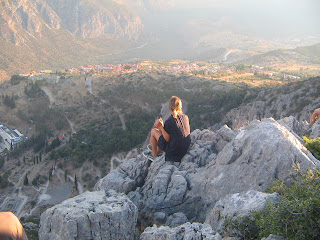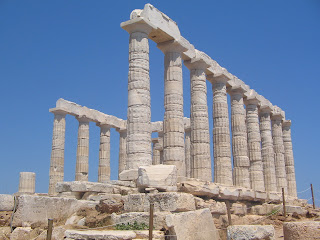Things in Greece are coming to a rapid and alarming conclusion. I can't believe that I only have a meagre two weeks to enjoy myself here at Tragana. It feels odd as on one hand I cant imagine that I have in fact been over here for 2 months already, but on the other I am relieved that I am going to be able to take time to recover from the rigours of excavation and the harsh living conditions. This last week has been, as always, both interesting, difficult and incredibly memorable all at the same time. Unfortunately, I find myself at the computer without my USB flash drive so photos will have to wait. IM SORRY I FORGOT!
Excavation wise, we have been chasing a beautiful pink marl plaster floor that we think is just below where we are currently at. Unfortunately, between us and the prize have consistently turned up layer after layer of 'surface'. Surfaces are the most annoying thing in the world to excavate. They are indicated by a slight hardening of the soil, maybe a colour change, and perhaps if you are lucky some flat lying sherds of pottery or a bunch of pebbles. They are very difficult to identify while digging as you are required to feel subtle differences in soil density with your trowel. Even when you 'find' them they are almost always patchy and you loose them within seconds. As they are supposed to indicate occupation of the area, we have to take photographs and everything every single time we come across one. Most of those in our trench are convinced these surfaces are nothing more that phantoms and have so named them 'DURfaces'.
While digging our way towards the marl floor, we uncovered two very substantial walls running on a completely different axis to what we have already in the trench and also quite a bit deeper. This means that they are walls from a different occupational period and are very exciting. They are part of a new building which our trench seems to luckily encompass the inside. We are looking very forward to proceeding deeper to see what we will find inside this new building.
This weekend our trip was to the famous and magnificent site of Delphi. This is the place of the legendary 'Oracle of Delphi' which was world famous all the way from Archaic Greece (c. 800BC) to Roman times. People from far and wide made pilgrimage to the site in order to ask the oracle about what the future had in store for them. Cities and Empires from across the globe also asked about pressing political concerns, matters of war and colonisation. It was indeed one of the most important sanctuaries in Greece. The place is pretty impressive. It is set on the slopes of Mt. Parnassos, and overlooks the extremelly majestic surrounding countryside.
Excavation wise, we have been chasing a beautiful pink marl plaster floor that we think is just below where we are currently at. Unfortunately, between us and the prize have consistently turned up layer after layer of 'surface'. Surfaces are the most annoying thing in the world to excavate. They are indicated by a slight hardening of the soil, maybe a colour change, and perhaps if you are lucky some flat lying sherds of pottery or a bunch of pebbles. They are very difficult to identify while digging as you are required to feel subtle differences in soil density with your trowel. Even when you 'find' them they are almost always patchy and you loose them within seconds. As they are supposed to indicate occupation of the area, we have to take photographs and everything every single time we come across one. Most of those in our trench are convinced these surfaces are nothing more that phantoms and have so named them 'DURfaces'.
While digging our way towards the marl floor, we uncovered two very substantial walls running on a completely different axis to what we have already in the trench and also quite a bit deeper. This means that they are walls from a different occupational period and are very exciting. They are part of a new building which our trench seems to luckily encompass the inside. We are looking very forward to proceeding deeper to see what we will find inside this new building.
This weekend our trip was to the famous and magnificent site of Delphi. This is the place of the legendary 'Oracle of Delphi' which was world famous all the way from Archaic Greece (c. 800BC) to Roman times. People from far and wide made pilgrimage to the site in order to ask the oracle about what the future had in store for them. Cities and Empires from across the globe also asked about pressing political concerns, matters of war and colonisation. It was indeed one of the most important sanctuaries in Greece. The place is pretty impressive. It is set on the slopes of Mt. Parnassos, and overlooks the extremelly majestic surrounding countryside.

 There are remains of a large Gymnasium, a temple to Athena, a large theatre and a huge stadium used for the famous Pythian Games held every two years. The main attractions here though are the large Temple to Apollo (where the Oracle sat and spoke the words of the god to the pilgrims) and the large city treasuries built by many different states across Greece to hold their dedications to the sanctuary.
There are remains of a large Gymnasium, a temple to Athena, a large theatre and a huge stadium used for the famous Pythian Games held every two years. The main attractions here though are the large Temple to Apollo (where the Oracle sat and spoke the words of the god to the pilgrims) and the large city treasuries built by many different states across Greece to hold their dedications to the sanctuary. 

After our visit to the various sites and Museums, we were encouraged to attend an optional hike to the top of Mt Parnassos directly behind the site. This was advertised as a 'easy walk to the top of the mountain with exceptional views of the bay and site'. As the guide had only done it 18 years ago, things maaaaay have been a little hazy to remember. It was not an 'easy walk to the top' but a veritable bushwhack through rough, thorny scrub that ripped and tore at our legs. We also lost the trail 3/4 of the way up and had to go offroad to find the edge of the mountain. Me and a couple others went on a scouting mission and finally found the place. It was possibly the best view I have yet to encounter in Greece. You had a perfect aerial view of the site and EVERYTHING around it. It was breathtaking. Photo's forthcoming!



I have to dash because my parents have just called :D
Adiossas and Kalispera!
 Needless to say, this diverted attention completely away from our original plans, and work was now focussed on clearing the trench around the grave so that the mortuary excavators could come in and open the grave. Curiously, code words have to be employed when we are not at site and talking about graves because we do not want the locals to think we are finding gold or anything of value. It would lead to looting and crowding of the sight and ultimately damage to the archaeological record. For these reaosns, we call graves 'Penguins'.
Needless to say, this diverted attention completely away from our original plans, and work was now focussed on clearing the trench around the grave so that the mortuary excavators could come in and open the grave. Curiously, code words have to be employed when we are not at site and talking about graves because we do not want the locals to think we are finding gold or anything of value. It would lead to looting and crowding of the sight and ultimately damage to the archaeological record. For these reaosns, we call graves 'Penguins'.



 The whole setting was incredible, and the view spectacular. I am sure that even a god must have been pleased.
The whole setting was incredible, and the view spectacular. I am sure that even a god must have been pleased. 


